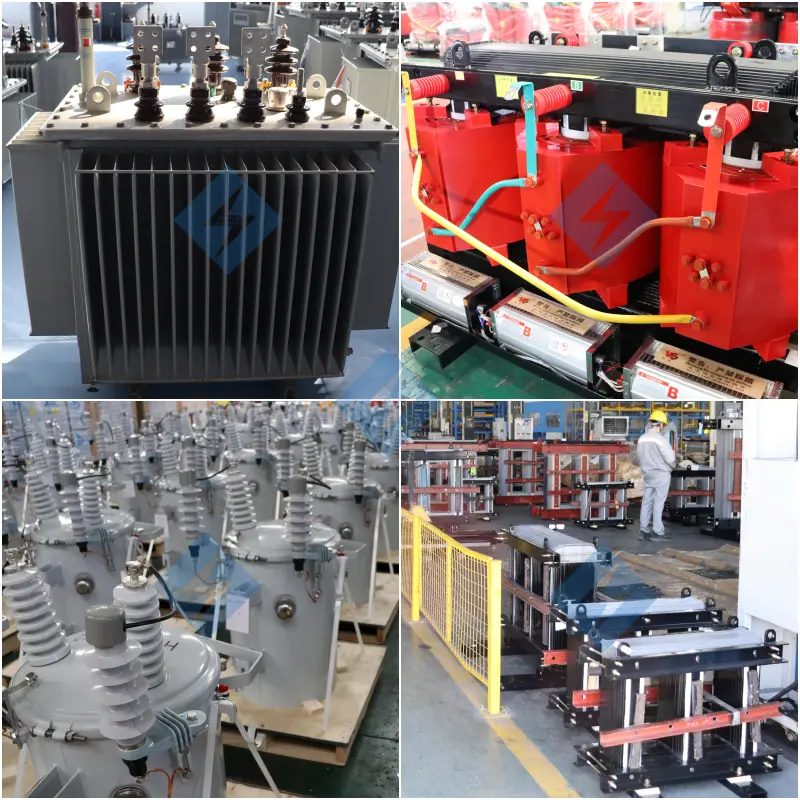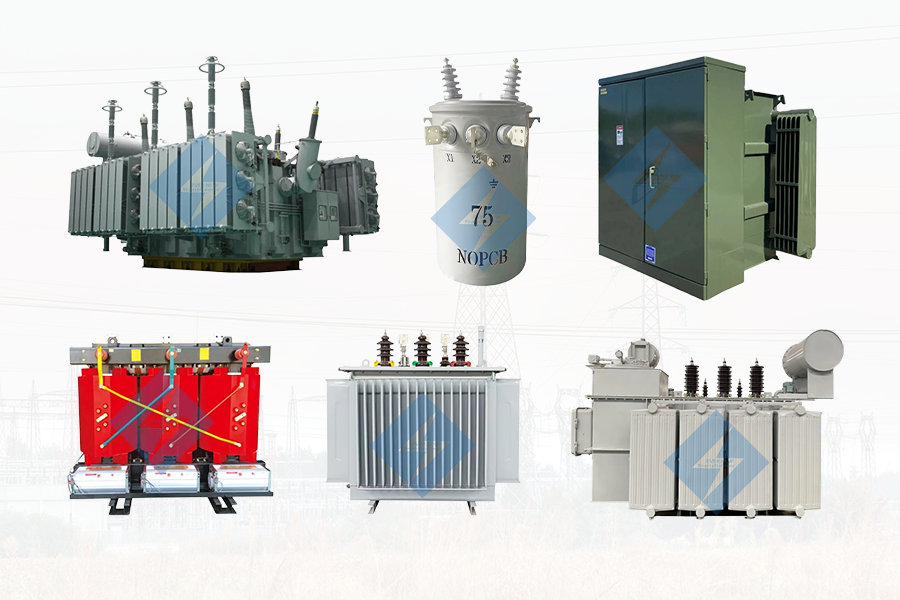Transformers are essential components in modern power systems, enabling the efficient transmission and distribution of electricity across vast distances. By adjusting voltage levels, transformers ensure the safe and reliable operation of electrical devices in residential, commercial, and industrial settings.
In this guide, we’ll explore the main types of electrical transformers, their classifications based on different criteria, and common applications across industries.
Understanding Transformer Classifications
Transformers can be categorized based on several factors, including their function, core structure, winding configuration, and usage. Below is a breakdown of the most common classifications:
1. Classification by Function (Voltage Transformation Purpose)
✅ Step-Up Transformers
Designed to increase the voltage from a lower input level to a higher output level. Commonly used in power plants to raise voltage levels before long-distance transmission, reducing energy losses.
✅ Step-Down Transformers
Used to reduce high transmission voltages to safer, usable levels for homes, factories, and businesses. Examples include distribution transformers that provide power to neighborhoods or specific facilities.
✅ Isolation Transformers
These provide electrical isolation between the input and output, minimizing risks of electric shock and equipment damage. Common in sensitive applications such as hospitals, laboratories, and industrial controls.
2. Classification by Core Material
✅ Iron Core Transformers
The core is made of laminated silicon steel sheets, enhancing magnetic flux linkage and overall efficiency. Widely used in power generation, transmission, and industrial applications due to their high magnetic permeability.
✅ Air Core Transformers
Instead of a magnetic core, these rely on air for magnetic flux conduction. Suitable for high-frequency applications like radio transmitters, wireless chargers, and certain scientific instruments.
3. Classification by Winding Configuration
✅ Two-Winding Transformers
The traditional transformer design with separate primary and secondary windings. Suitable for significant voltage differences between input and output.
✅ Autotransformers
Feature a shared winding for both primary and secondary circuits. Compact and cost-effective, ideal for voltage regulation where the voltage change is relatively small.
✅ Three-Winding Transformers
Incorporate three separate windings—high, medium, and low voltage—allowing multiple outputs. Used in complex industrial power systems and substations.
4. Classification by Application
✅ Power Transformers
Built for high voltage applications (3000kVA to 100MVA), primarily installed in substations to handle bulk power transfer over long distances.
✅ Distribution Transformers
Operate at lower voltages, distributing power to end-users like homes, commercial buildings, and factories. Typically rated below 3000kVA.
✅ Instrument Transformers (Current and Voltage Transformers)
Provide safe, scaled-down measurements of current and voltage for metering and protection in power systems.
✅ Special Purpose Transformers
Include furnace transformers, rectifier transformers, and phase-shifting transformers designed for specific industrial processes like steel production, electrolysis, and smelting.
5. Classification by Application – Liquid Filled vs. Dry Type Transformers
Transformers are selected based on their insulation type and application scenarios. Below is a clear breakdown of how liquid filled and dry type transformers are applied in various industries and environments:

✅ Outdoor Power Distribution – Liquid Filled Transformers
Pad-Mounted Transformers
- Tamper-proof, ground-mounted design with load-break switches and fuses
- Common in residential areas, shopping malls, airports, and campuses
Read More:Comprehensive Guide to Pad Mount Transformer
Pole-Mounted Transformers
- Compact, single-phase transformers installed on utility poles
- Widely used for rural power distribution and residential neighborhoods
Substation Transformers
- Large-capacity, oil-filled units with external cooling systems
- Handle heavy industrial loads and support utility substations
Learn More:What is a Substation Transformer
Vault / Network Transformers
- Waterproof, compact, and designed for underground installations
- Ideal for densely populated urban areas, metro systems, and high-rise buildings
✅ Indoor Power Distribution – Dry Type Transformers
Low-Voltage Dry Type Transformers
- Rated up to 600V, perfect for indoor commercial and light industrial use
Medium-Voltage Dry Type Transformers
- Serve medium-voltage networks in factories, large facilities, and buildings
Cast Coil Transformers
- Windings fully encapsulated in epoxy for moisture and corrosion resistance
- Best suited for wet, corrosive, or harsh environments
Encapsulated Transformers
- Sealed with sand and resin to protect against dust, dirt, and humidity
- Common in chemical plants, factories, and outdoor kiosks
✅ Special Purpose Dry Type Transformers
Autotransformers
- Compact design with a shared primary and secondary winding
- Cost-effective for voltage adjustment when electrical isolation is not required
Drive Isolation Transformers
- Designed to handle harmonics from VFDs and motor drives
- K-rated with electrostatic shielding to protect sensitive equipment
Read Now:What is Dry Type Transformer
Key Applications of Transformers
Transformers are indispensable in numerous sectors. Here are five major application areas:
✅ 1. Power Generation, Transmission, and Distribution
From power stations to end-users, transformers enable efficient energy flow, minimizing losses during long-distance transmission and adapting voltage levels to user needs.
✅ 2. Industrial Processes
Manufacturing plants rely on specialized transformers to power heavy machinery, furnaces, and electrochemical processes like smelting and electroplating, where stable voltage is critical.
✅ 3. Electrical Equipment Protection and Isolation
Isolation transformers protect sensitive equipment from electrical noise, surges, and faults. Essential in data centers, hospitals, and research facilities.
✅ 4. Renewable Energy Systems
Transformers play a vital role in solar farms and wind power plants, converting generated power to suitable levels for grid integration.
✅ 5. Emerging Technologies and Modern Applications
With the rise of electric vehicles, transformers are integral to EV charging infrastructure, battery storage systems, and crypto mining operations requiring stable high-capacity power.
How to Select the Right Transformer?
Choosing the right transformer depends on several critical factors:
- Rated Power Capacity (kVA/MVA)
- Primary and Secondary Voltage Levels
- Frequency Compatibility (Hz)
- Phase Type (Single-phase or Three-phase)
- Core Type (Air or Iron Core)
- Environment (Indoor, Outdoor, Hazardous Areas)
Proper selection ensures efficiency, longevity, and safety of your electrical systems.
Evernew Transformer – Your Reliable Transformer Manufacturer
As a professional power transformer manufacturer with over 20 years of experience, Evernew Transformer offers a wide range of products to meet global energy demands, including:
✅ High Voltage Power Transformers
✅ Distribution Transformers (Oil-filled and Dry-type)
✅ Pad-mounted and Pole-mounted Transformers
✅ Special Transformers for Renewable Energy and Industrial Use
We serve clients across North America, South America, Asia, and the Middle East, providing customized solutions, OEM/ODM services, and fast delivery.
Conclusion
Transformers are the backbone of modern power infrastructure. Understanding the different types and their applications helps in making informed choices for your projects, whether it’s utility-scale power distribution or specialized industrial operations.
Contact Evernew Transformer today for expert guidance and reliable transformer solutions tailored to your needs.

